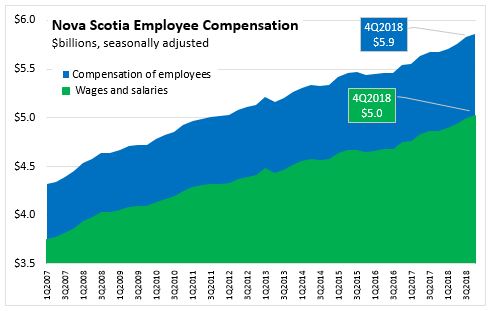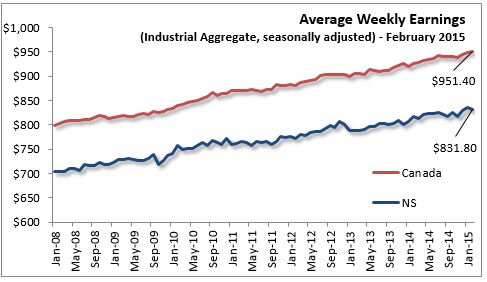To view previous releases, select one from the dropdown box:
Currently displaying information released on: March, 2019
LABOUR FORCE SURVEY - FEBRUARY 2019
In Nova Scotia February 2019, (seasonally-adjusted, month-over-month and year-over-year):
- Labour Force decreased 0.1 per cent (-700) from January 2019 to 498,500 and increased 0.8 per cent (3,900) over February 2018.
- Employment increased 0.3 per cent (1,400) from January 2019 to 466,500 and increased 2.4 per cent (10,800) over February 2018.
- Unemployment decreased 6.1 per cent (-2,100) from January 2019 to 32,100 and decreased 17.5 per cent...
View complete article..
LABOUR MARKET TRENDS - FEBRUARY 2019
Nova Scotia's seasonally adjusted employment increased by 1,400 to 466,500 in February 2019. This marks the eighth consecutive month of employment growth and the highest level of employment in the 43-year history of the labour force survey.
Compared to January, Nova Scotia’s labour force decreased by 700 to 498,500 in February. Unemployment declined by 2,100, and with employment increasing, the net result was a 0.5 percentage point decrease in the seasonally adjusted unemployme...
View complete article..
JOB VACANCIES AND WAGES, 2018 Q4 AND ANNUAL
Statistics Canada has released its quarterly job vacancy and wage survey (unadjusted for seasonality) for the fourth quarter of 2018. This data provides insight into what portion of jobs in a particular region, sector or occupation are vacant. It also provides information on the wages offered and specific requirements for each type of vacant job. A higher job vacancy rate indicates a tighter labour market where it is more difficult for employers to find suitable candidates for the...
View complete article..
COMPENSATION OF EMPLOYEES Q4 2018

Nova Scotia's seasonally adjusted employee compensation (wages+salaries+employer social contributions) increased 0.6 per cent in the fourth quarter of 2018 to $5.86 billion. Compared to the fourth quarter of 2017 compensation was up 3.3 per cent, a faster pace than the previous four quarters.
The wages and salaries portion of employee compensation was up 0.6 per cent...
View complete article..
EMPLOYMENT INSURANCE FEBRUARY 2015
In February 2015, the number (seasonally adjusted) of Nova Scotians receiving regular Employment Insurance (EI) benefits increased by 580 persons (2.2%) from the previous month to 27,190 and increased by 160 persons (0.6%) over February 2014.
In February 2015, the number (seasonally adjusted) of Canadians receiving regular EI benefits increased by 9,940 persons (2.0%) from the previous month to 509,780 and declined by 3,470 (-0.7%) over February ...
View complete article..
EMPLOYMENT, EARNINGS AND HOURS, FEBRUARY 2015
Nova Scotians' average weekly earnings (including overtime, seasonally adjusted) decreased $3.98 per week (-0.5%) from January to $831.80 in February 2015. This is 1.9 per cent above the level in February of last year. Canadians' average weekly wages increased 0.3 per cent from January to $951.40 in February 2015, a 2.7 percent increase over February 2014.

View complete article..
|